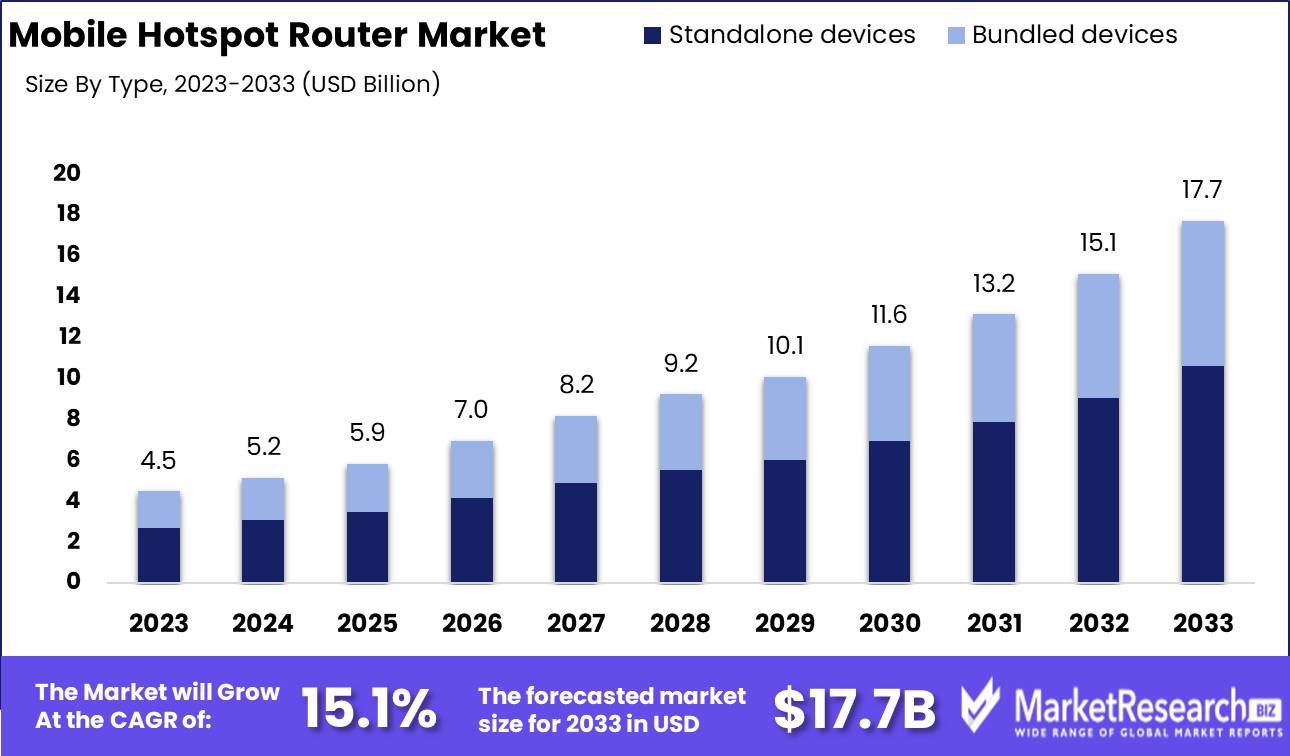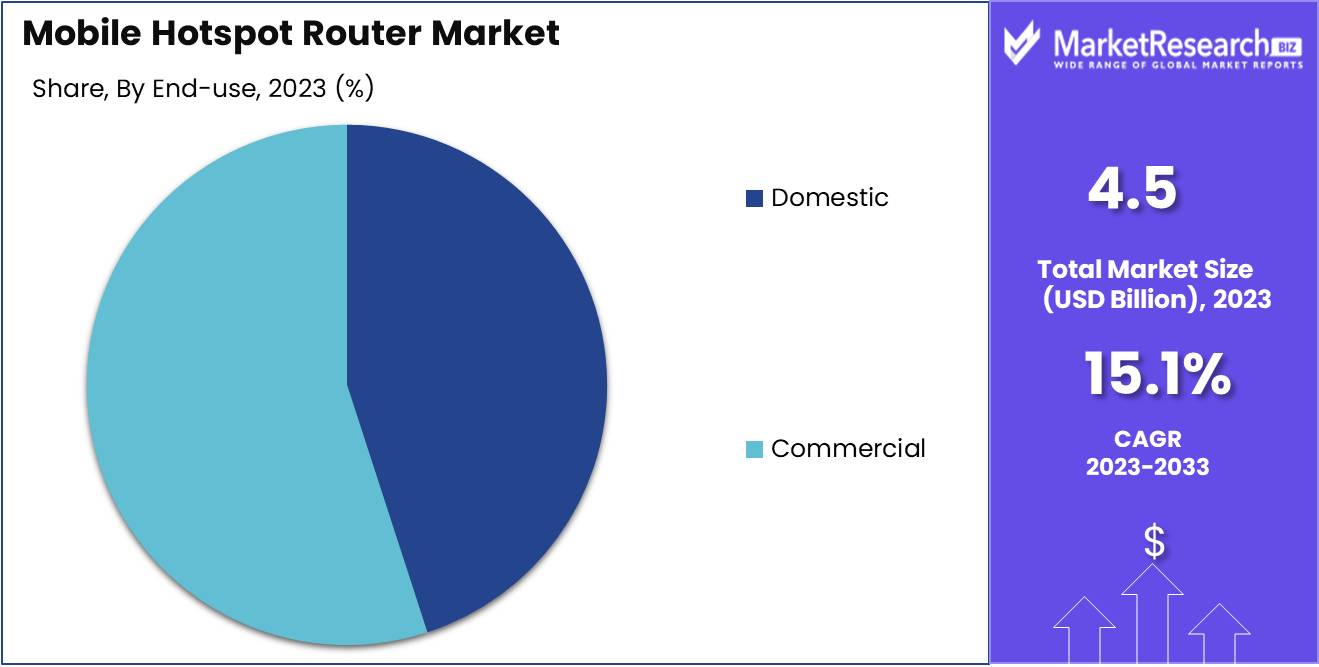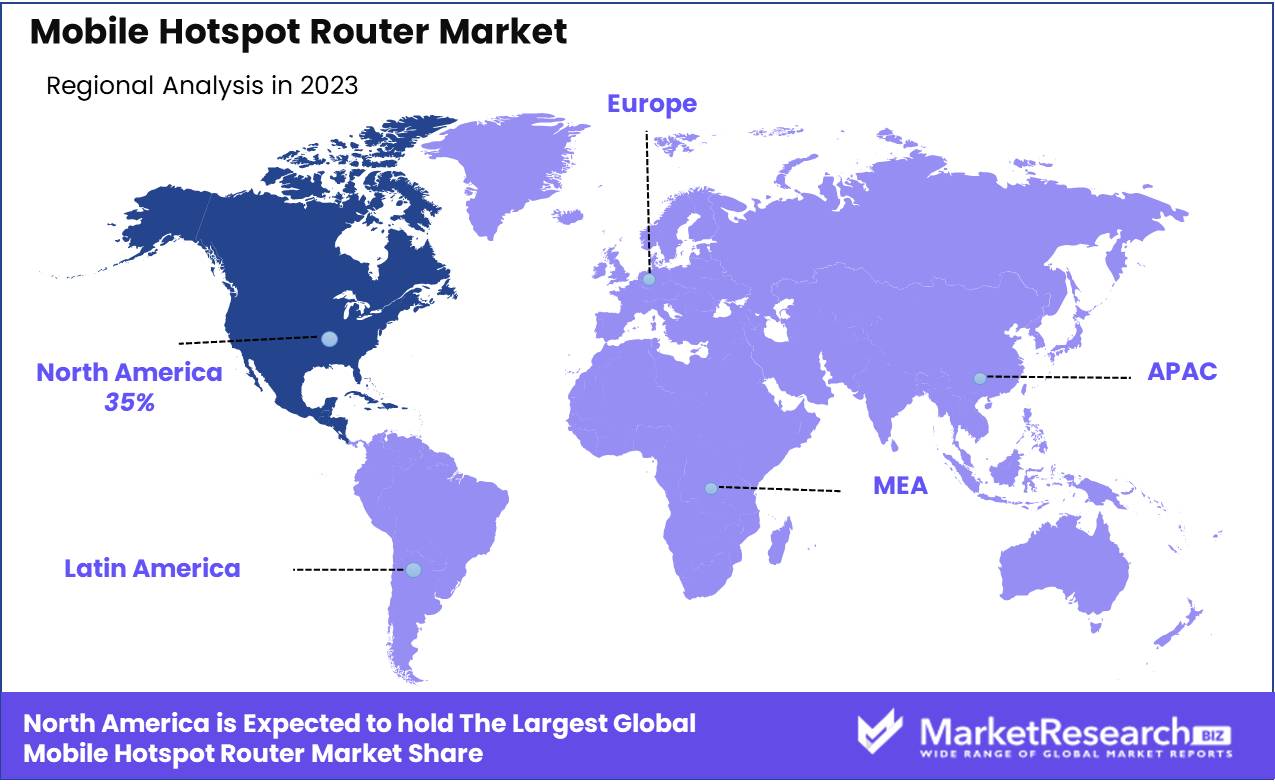
Mobile Hotspot Router Market By Type (Standalone devices, Bundled devices), By End-use (Domestic, Commercial), By Region and Companies - Industry Segment Outlook, Market Assessment, Competition Scenario, Trends and Forecast 2024-2033
-
48739
-
July 2024
-
137
-
-
This report was compiled by Vishwa Gaul Vishwa is an experienced market research and consulting professional with over 8 years of expertise in the ICT industry, contributing to over 700 reports across telecommunications, software, hardware, and digital solutions. Correspondence Team Lead- ICT Linkedin | Detailed Market research Methodology Our methodology involves a mix of primary research, including interviews with leading mental health experts, and secondary research from reputable medical journals and databases. View Detailed Methodology Page
-
Quick Navigation
Report Overview
The Global Mobile Hotspot Router Market was valued at USD 4.5 Bn in 2023. It is expected to reach USD 17.7 Bn by 2033, with a CAGR of 15.1% during the forecast period from 2024 to 2033.
The Mobile Hotspot Router Market encompasses the production, distribution, and utilization of portable devices that provide internet connectivity through wireless networks. These routers enable multiple devices to connect to the internet simultaneously via Wi-Fi, utilizing cellular data networks. Key drivers include the increasing demand for remote work solutions, rising adoption of smart devices, and growing need for reliable internet access on-the-go.
 Technological advancements, such as 5G integration and enhanced security features, are propelling market growth. This sector is critical for enabling mobile connectivity, offering flexibility, and supporting the digital transformation of businesses and consumers globally. The Mobile Hotspot Router Market is witnessing substantial growth, driven by the increasing demand for remote work solutions, the proliferation of smart devices, and the necessity for reliable internet connectivity on-the-go.
Technological advancements, such as 5G integration and enhanced security features, are propelling market growth. This sector is critical for enabling mobile connectivity, offering flexibility, and supporting the digital transformation of businesses and consumers globally. The Mobile Hotspot Router Market is witnessing substantial growth, driven by the increasing demand for remote work solutions, the proliferation of smart devices, and the necessity for reliable internet connectivity on-the-go.The concept of using a cellular network to provide wireless internet access to multiple devices emerged in the early 2000s, catalyzed by advancements in cellular data networks and Wi-Fi technology. This market has evolved significantly with the advent of 5G technology, which offers unprecedented speeds and connectivity. The Nighthawk M6 supports 5G connectivity with speeds up to 2.5Gbps, achieving download speeds up to 92Mbps and upload speeds up to 40Mbps on AT&T's 5G network.
These technological advancements have broadened the application of mobile hotspot routers across various sectors, including enterprise, education, and healthcare, facilitating seamless connectivity in diverse environments. The integration of enhanced security features ensures secure data transmission, addressing growing concerns about data privacy and cyber threats. The increasing reliance on cloud-based applications and services further underscores the importance of mobile hotspot routers in maintaining continuous, high-speed internet access.
Key Takeaways
- Market Value: The Global Mobile Hotspot Router Market was valued at USD 4.5 Bn in 2023. It is expected to reach USD 17.7 Bn by 2033, with a CAGR of 15.1% during the forecast period from 2024 to 2033.
- By Type: By Type, standalone devices dominate the Mobile Hotspot Router Market, accounting for 60% of the share.
- By End-use: By End-use, the commercial segment holds a significant 55% share of the Mobile Hotspot Router Market.
- Regional Dominance: North America holds approximately 40% of the global Mobile Hotspot Router Market share.
- Growth Opportunity: The increasing demand for remote work and internet connectivity in rural areas presents a significant growth opportunity for the Mobile Hotspot Router Market.
Driving factors
Remote Work and Virtual Learning
The surge in remote work and virtual learning has significantly contributed to the growth of the mobile hotspot router market. With a large portion of the global workforce shifting to remote work setups and educational institutions adopting online learning platforms, the need for reliable internet connectivity has become paramount. The pandemic accelerated this trend, and even as the world recovers, many organizations and schools continue to embrace flexible work and learning arrangements.
This shift has led to a substantial increase in the demand for mobile hotspot routers, which provide a portable and reliable internet connection, enabling employees and students to stay connected from any location.
Continuous Internet Connectivity While Traveling
The increasing demand for uninterrupted internet connectivity while traveling has also fueled the growth of the mobile hotspot router market. As more people travel for both leisure and work, the need for a reliable and secure internet connection has become essential.
Mobile hotspot routers offer a convenient solution by providing continuous internet access on the go, allowing users to stay connected to their work, social media, and online entertainment without relying on potentially insecure public Wi-Fi networks. This growing need for seamless connectivity during travel has driven the adoption of mobile hotspot routers, contributing to market expansion.
4G and 5G Technology Propel
Advancements in 4G and 5G technology have been pivotal in driving the growth of the mobile hotspot router market. The enhanced speed, reliability, and coverage of 4G and the revolutionary improvements brought by 5G technology have made mobile hotspot routers more efficient and appealing to consumers.
5G technology, in particular, offers ultra-fast internet speeds, low latency, and the capacity to connect multiple devices simultaneously, making it ideal for remote work, virtual learning, and on-the-go connectivity. As these technologies continue to evolve and become more widespread, the capabilities and appeal of mobile hotspot routers are expected to increase, further propelling market growth.
Restraining Factors
High Cost of Data Plans Limits Market Penetration
The high cost of data plans is a significant factor that can limit the growth of the mobile hotspot router market. While mobile hotspot routers provide the convenience of internet connectivity on the go, the expense of data plans required to use these devices can be a deterrent for many potential users.
High data costs can make the overall cost of using a mobile hotspot router prohibitive, especially for users who need to connect multiple devices or require large amounts of data. This financial barrier can slow market adoption and limit the expansion of the customer base.
Limited Battery Life Restrains Usability and Growth
Limited battery life of mobile hotspot routers is another critical factor that can hinder market growth. These devices are often relied upon for providing internet connectivity in various locations, including during travel or in remote work environments.
If the battery life of these routers is insufficient, users may find themselves frequently needing to recharge the device, which can be inconvenient and disruptive to continuous internet use. This limitation can reduce the overall attractiveness of mobile hotspot routers, potentially affecting user satisfaction and slowing down the market growth.
By Type Analysis
By Type Standalone devices held a dominant market position, capturing more than a 60% share.
In 2023, standalone devices held a dominant market position in the mobile hotspot router market, capturing more than a 60% share. The substantial market share of standalone devices can be attributed to their advanced features, superior connectivity options, and enhanced battery life compared to bundled devices. Standalone devices offer users the flexibility to connect multiple devices without compromising on internet speed or connectivity quality, making them a preferred choice among consumers and enterprises alike.
Bundled devices, while not as dominant, still hold a significant portion of the market. These devices are often included as part of broader service packages offered by telecommunications providers, making them a cost-effective solution for consumers. Bundled devices typically cater to price-sensitive customers who value the convenience of acquiring both the device and service plan from a single provider.
By End-use Analysis
By End-use Commercial applications held a dominant market position, capturing more than a 55% share.
In 2023, the commercial segment held a dominant market position in the mobile hotspot router market, capturing more than a 55% share. The substantial market share of the commercial segment can be attributed to the increasing reliance of businesses on mobile internet connectivity to support remote work, enhance operational efficiency, and maintain seamless communication with clients and stakeholders.
The domestic segment, while not as dominant as the commercial segment, still represents a significant portion of the market. The demand for mobile hotspot routers in domestic settings is driven by the increasing number of smart homes systems, the proliferation of connected devices, and the growing trend of remote learning and home-based entertainment. Households are increasingly opting for mobile hotspot routers to ensure uninterrupted internet connectivity, especially in areas with limited broadband infrastructure or during travel.

Key Market Segments
By Type
- Standalone devices
- Bundled devices
By End-use
- Domestic
- Commercial
Growth Opportunity
Expansion into Emerging Markets
The global mobile hotspot router market is poised for significant growth in 2024, driven by the expansion into emerging markets. Countries in Asia, Africa, and Latin America present untapped potential due to their increasing internet penetration rates and growing adoption of digital technologies.
As these regions continue to develop their digital infrastructure, the demand for mobile hotspot routers is expected to rise. The affordability and convenience of these devices make them ideal solutions for providing reliable internet access in areas with limited fixed broadband availability.
Development of Multi-Functional Devices
The development of multi-functional mobile hotspot routers is another key opportunity for market growth. Consumers are increasingly seeking devices that offer more than just internet connectivity. Manufacturers are responding by integrating additional features such as power banks, media storage, and network security functions into mobile hotspot routers.
This innovation enhances the value proposition of these devices, making them more attractive to a broader audience. The market is seeing an increase in demand for such versatile devices, as they cater to the evolving needs of consumers who prioritize convenience and multi-purpose functionality.
Integration of Advanced Technologies
Advancements in 4G and 5G service continue to play a crucial role in the mobile hotspot router market. The rapid deployment of 5G networks globally is expected to drive the demand for high-speed, low-latency internet connectivity solutions. Mobile hotspot routers equipped with 5G capabilities offer significantly improved performance, supporting multiple devices and higher data speeds.
Latest Trends
Integration of IoT Capabilities
One of the prominent trends in the mobile hotspot router market for 2024 is the integration of Internet of Things (IoT) capabilities. As the IoT ecosystem continues to expand, there is an increasing need for robust and reliable connectivity solutions to support the myriad of connected devices.
Mobile hotspot routers with IoT capabilities offer seamless connectivity for smart home devices, wearable technology, and industrial IoT applications. These routers can efficiently manage multiple connections, ensuring stable and high-speed internet access for all connected devices.
Preference for Compact and Portable Devices
Consumers are increasingly favoring compact and portable mobile hotspot routers, driven by the need for convenience and mobility. The modern consumer values devices that are easy to carry and use, whether for travel, remote work, or everyday connectivity needs. Manufacturers are responding to this trend by developing smaller, lightweight routers without compromising on performance and battery life.
This preference for portability is particularly strong among digital nomads, remote workers, and frequent travelers who require reliable internet access on the go. The increasing demand for such devices is expected to significantly influence market dynamics in 2024.
Regional Analysis
North America holds the largest share of the Mobile Hotspot Router Market, accounting for 40% of the global market. This dominance is driven by the high penetration of advanced wireless technologies and the substantial presence of leading market players. The robust infrastructure supporting high-speed internet connectivity further bolsters market growth. The increasing demand for seamless connectivity in remote and rural areas also contributes to the expanding market in this region.
Europe represents a significant portion of the Mobile Hotspot Router Market, driven by the rising adoption of mobile and wireless devices. Countries like Germany, the UK, and France are leading the market due to their advanced telecommunications infrastructure and high internet penetration rates.
The Asia Pacific region is experiencing rapid growth in the Mobile Hotspot Router Market, supported by the increasing number of internet users and the expansion of 4G and 5G networks.The burgeoning e-commerce sector and the increasing trend of remote working are key factors propelling the demand for mobile hotspots.
The Middle East & Africa region is gradually expanding its footprint in the Mobile Hotspot Router Market, primarily driven by the increasing demand for internet connectivity in remote and underserved areas.
Latin America is witnessing a steady growth in the Mobile Hotspot Router Market, fueled by the increasing penetration of smartphones and the growing need for internet access. The demand for mobile hotspots is particularly high among the younger demographic and small businesses that require affordable and flexible internet solutions.

Key Regions and Countries
North America
- US
- Canada
- Mexico
Western Europe
- Germany
- France
- The UK
- Spain
- Italy
- Portugal
- Ireland
- Austria
- Switzerland
- Benelux
- Nordic
- Rest of Western Europe
Eastern Europe
- Russia
- Poland
- The Czech Republic
- Greece
- Rest of Eastern Europe
APAC
- China
- Japan
- South Korea
- India
- Australia & New Zealand
- Indonesia
- Malaysia
- Philippines
- Singapore
- Thailand
- Vietnam
- Rest of APAC
Latin America
- Brazil
- Colombia
- Chile
- Argentina
- Costa Rica
- Rest of Latin America
Middle East & Africa
- Algeria
- Egypt
- Israel
- Kuwait
- Nigeria
- Saudi Arabia
- South Africa
- Turkey
- United Arab Emirates
- Rest of MEA
Key Players Analysis
The global Mobile Hotspot Router Market in 2024 is poised for significant growth, driven by the increasing demand for high-speed internet connectivity and the proliferation of smart devices. Key players in this market are well-positioned to capitalize on these trends, leveraging their technological expertise and expansive product portfolios.
Belkin International Inc. is expected to maintain a strong market presence due to its innovative product designs and robust distribution channels. The company's focus on integrating advanced features and user-friendly interfaces into its mobile hotspot routers will likely attract a broad consumer base.
Alcatel will continue to be a significant player, leveraging its brand recognition and strategic partnerships. The company's commitment to affordability without compromising on performance makes it a preferred choice in emerging markets.
Huawei Technologies is anticipated to lead the market, thanks to its extensive R&D capabilities and a wide range of high-performance mobile hotspot routers. Despite facing geopolitical challenges, Huawei's dominance in the 5G sector and its ability to offer competitively priced products will sustain its market position.
D-Link Corporation is expected to grow its market share by focusing on product innovation and expanding its presence in the enterprise sector. Its routers' reputation for reliability and advanced features will continue to drive demand.
Karma Mobility and TP-Link Technologies Co. Ltd are likely to gain traction by targeting niche segments and enhancing their product offerings. Karma's emphasis on pay-as-you-go services and TP-Link's strength in providing cost-effective solutions will be key growth drivers.
XCom Global Inc. and NETGEAR will benefit from their strong brand equity and expansive distribution networks. XCom's focus on international travelers and NETGEAR's emphasis on high-speed, secure connectivity solutions position them well for market expansion.
ZTE and Novatel Wireless Inc. will continue to leverage their technological advancements and strategic partnerships to capture market share. ZTE's competitive pricing and Novatel's innovation in mobile hotspot technology will be pivotal in their growth strategies.
Market Key Players
- Belkin International Inc.
- Alcatel
- Huawei Technologies
- D-Link Corporation
- Karma Mobility
- TP-Link Technologies Co. Ltd
- XCom Global Inc.
- NETGEAR
- ZTE
- Novatel Wireless Inc.
Recent Development
- June 2024: Verizon Wireless expanded its mobile hotspot services with new 5G capabilities, enhancing speed and connectivity for users.
- April 2024: TP-Link introduced a new range of mobile hotspot routers designed to offer improved battery life and multi-device connectivity, targeting remote workers and travelers.
Report Scope
Report Features Description Market Value (2023) USD 4.5 Bn Forecast Revenue (2033) USD 17.7 Bn CAGR (2024-2033) 15.1% Base Year for Estimation 2023 Historic Period 2018-2023 Forecast Period 2024-2033 Report Coverage Revenue Forecast, Market Dynamics, Competitive Landscape, Recent Developments Segments Covered By Type (Standalone devices, Bundled devices), By End-use (Domestic, Commercial) Regional Analysis North America - The US, Canada, & Mexico; Western Europe - Germany, France, The UK, Spain, Italy, Portugal, Ireland, Austria, Switzerland, Benelux, Nordic, & Rest of Western Europe; Eastern Europe - Russia, Poland, The Czech Republic, Greece, & Rest of Eastern Europe; APAC - China, Japan, South Korea, India, Australia & New Zealand, Indonesia, Malaysia, Philippines, Singapore, Thailand, Vietnam, & Rest of APAC; Latin America - Brazil, Colombia, Chile, Argentina, Costa Rica, & Rest of Latin America; Middle East & Africa - Algeria, Egypt, Israel, Kuwait, Nigeria, Saudi Arabia, South Africa, Turkey, United Arab Emirates, & Rest of MEA Competitive Landscape Belkin International Inc., Alcatel, Huawei Technologies, D-Link Corporation, Karma Mobility, TP-Link Technologies Co. Ltd, XCom Global Inc., NETGEAR, ZTE, Novatel Wireless Inc. Customization Scope Customization for segments, region/country-level will be provided. Moreover, additional customization can be done based on the requirements. Purchase Options We have three licenses to opt for: Single User License, Multi-User License (Up to 5 Users), Corporate Use License (Unlimited User and Printable PDF) -
-
- Belkin International Inc.
- Alcatel
- Huawei Technologies
- D-Link Corporation
- Karma Mobility
- TP-Link Technologies Co. Ltd
- XCom Global Inc.
- NETGEAR
- ZTE
- Novatel Wireless Inc.




